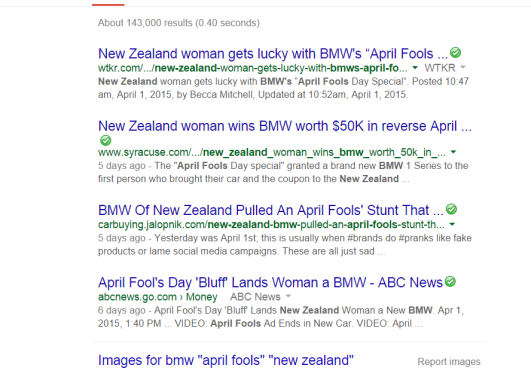
On April 1st, a BMW dealership in New Zealand ran a newspaper ad. At the bottom, it added an ‘April Fool’s Day Special’ coupon. The coupon said that the first person to bring the coupon in and ask for ‘Tom’, would be able to trade their old car in for a new BMW.
Here’s what happened:
Now, let’s look at this giveaway as being a marketing campaign. First, let’s consider the costs. There’s the cost of the BMW itself. Then add on the cost to create the video you just watched. Let’s assume there were also some costs associated with PR efforts around the giveaway. Add in any miscellaneous costs and let’s assume a total cost of say….$60,000.00.
Now, what did this BMW dealership gain from the giveaway? Let’s look at earned media generated:
First, there’s currently over 1.3 million views of the above video on YouTube. The odds are it will eventually approach 2 million views, if not pass that.
Next, we have earned media in the form of articles written about the giveaway. I googled “BMW new zealand april fools” and found 143,000 results:
Then you have to consider the coverage that this giveaway got on television and radio shows. This is just the type of giveaway that morning radio and television shows love to cover. “Hey did you hear about the woman that answered the April Fool’s ad and won a free BMW?”
Additionally, it’s going to drive an increase in foot traffic to the BMW dealership, and will likely result in increased sales from this giveaway. Many people will appreciate the fact that this dealership did the giveaway, and it will make them at least consider doing business there. Also, if the dealership wants to do something similar in the future, it can expect a much higher response rate for its newspaper ad call-to-action!
So for $60,000, here’s what this business got:
I think most businesses that could afford to spend $60,000 on its marketing would consider this to be a good investment.
The key to the success of this campaign has been spreading the story via online channels. And the story spread online because it focused on the customer. If this dealership had created a video promoting the same BMW it gave away, that video would have generated a small fraction of the exposure that this giveaway created. Instead, this BMW dealership found a way to put the focus on the customer, and in doing so. made the video far more interesting. Putting the customer at the center of the giveaway and video makes the video more relevant to other customers.
Customer-centric content spreads further and faster than company-centric content.
